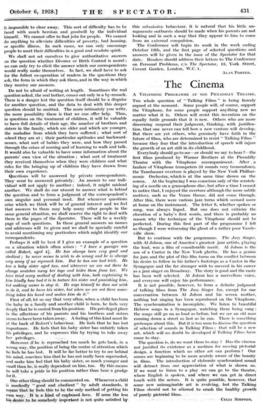The Cinema
A VITAPHONE PROGRAMME AT THE PICCADILLY THEATRE.
THE whole question of " Talking Films " is being fiercely argued at the moment. Some people will, of course, support the Vitaphone, for some people support anything new no matter what it is. Others will resist this invention on the equally futile grounds that it is new. Others who are more discerning suspend their judgment, thinking, with justifica- tion, that one never can tell how a new venture will develop. But there are yet others, who genuinely have faith in the future of films, who are determined to resist " Talking Films " because they fear that the introduction of speech will injure the growth of an art still in its childhood.
Everybody should go to see—or should we say to hear ?—the first films produced by Warner Brothers at the Piccadilly Theatre with the Vitaphone accompaniment. After , a fanfare of Vitaphone trumpeters (it sounds very tremendous), the Tannhauser overture is played by the New York Philhar- monic Orchestra, which is at the same time shown on the screen. At the beginning I was conscious only of the scratch- ing of a needle on a gramophone disc, but after a time I ceased to notice that, I enjoyed the overture although the more subtle motives, such as the Venus theme, did not come through. After this, there were various jazz turns which seemed more at home on the instrument. The letter S, whether spoken or sung, was always lisped. But one dOes not criticize the elocution of a baby's first words, and there is probably no reason why the technique of the Vitaphone should not be perfected. During this -first part of the programme I felt as though I were witnessing the ghost of a rather poor Vaude- ville show.
But to continue with the programme. The Jazz Singer, with Al Jolson, one of America's greatest jazz artists, playing the lead, was a filni of considerable merit. Al Jolson is the son of a Cantor in the New York ghetto. He has a genius for jazz. and the plot of this film turns on the conflict between his desire to follow in his father's footsteps as a Cantor in the Synagogue and the far stronger wish to succeed in his career as a jazz singer on Broadway. The story is good and the caste has been well selected. Al Jolson has a marvellous voice, and everyone will enjoy his performance.
It is not possible, however, to form a definite judgment of talking films from The Jazz Singer for, except for one conversation between Al Jolson and his screen mother, nothing but singing has been reproduced on the Vitaphone. The synchronization is incomplete. We listen to beautiful Hebrew songs in a Synagogue, watching them being sung ; the songs still go on as loud as before, but we see an old man running down a street as fast as he can. There is something grotesque about this. But it is too soon to discuss the question of selection of sounds in Talking Films ; that will be a new art, which will no doubt be developed if Talking Films have come to stay.
The question is, do we want them to stay ? Has the cinema not justified its existence as a medium for moving pictorial design, a function which no other art can perform ? Our senses are beginning -to be more acutely aware of the beauty in films. The introduction of elaborate synchronized sound will detract from our appreciation of what is shown us. If we want to listen to a play we can go to the theatre, where English is spoken, and where we can get in direct touch with the actors. It is quite possible; however, that some new unimaginable art is evolving, but the Talking Films should not 'be allowed to crush the healthy growth of purely pictorial films. - CELIA SIMPSON.






















































 Previous page
Previous page